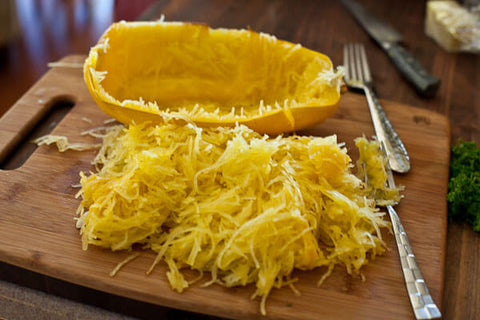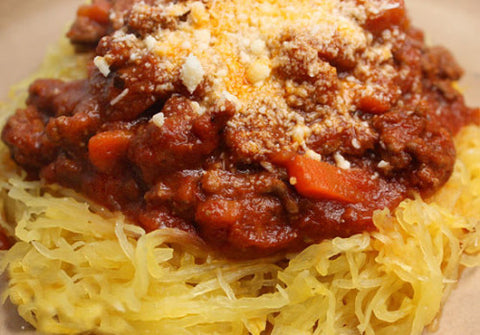Healthy Meal / garlic
Winter Veggie Favorites: Spaghetti Squash
The emphasis is on the spaghetti, not the squash! I was delighted the first time I made spaghetti squash, which, as the name suggests, is a lot like spaghetti inside. When compared to pasta, this squash has a lot more going! Here's the side by side comparison-
1 cup cooked pasta (made from white flour) has:
220 calories / 42 grams carbohydrates / very few nutrients
1 cup cooked spaghetti squash made by Mother Nature has:
42 calories / 10 grams carbohydrates / a good source of Niacin, Vitamin B6, Pantothenic Acid, Potassium and Manganese, and a good source of Dietary Fiber and Vitamin C.
I'll take nutrient dense, low carbohydrate plant food over-processed carbohydrates any day. Once you try this recipe, I think you'll agree!

photo courtesy of steamykitchen.com
How to Bake Spaghetti Squash
- Spaghetti squash are readily available this time of year, and easy to grow yourself, if you are planning your summer garden.
- Cut squash in half, lengthwise, from stem to end. Scoop out the seeds. Lightly oil the inside and then place, skin side up/cut side down, on a baking sheet.
- Bake at 350 for 25 minutes for a smaller squash, and up to 45 minutes for a big one.
- You want to make sure to cook thoroughly, and no more! Over baked spaghetti squash gets mushy, so check it towards the end by pressing the skin, when it's done it will give a little under the pressure.
- Remove from the oven, flip it over, and let it cool a bit. I use a clean kitchen towel to hold the squash in one hand and a fork to remove all the spaghetti like strands.
- Top with your favorite marinara, puttanesca or pesto sauce, or try Lottie's recipe below, which you can make ahead.

photo courtesy of runonveg.com
Slow Roasted Tomato Sauce
By Health Coach Lottie at RunOnVeg.com
Preheat oven 300/325 (depending on how hot your oven is)
-
2 cups cherry tomatoes
-
2 Rome tomatoes cut in half
-
2 medium size onions largely chopped (1 cup cooked)
-
6 garlic cloves
-
1/2 cup basil
-
1/2 cup water
-
1/4 cup Unsweetened Fire Cider or apple cider vinegar
-
salt to taste
Optional add in:
-
1/4 cup nutritional yeast
-
1-2 tablespoons hot sauce
-
2-3 dates
-
Line a baking sheet with parchment paper and non-stick spray. Place your tomatoes, onion and garlic on the baking sheet
-
Cook for 45-50 minutes until garlic is golden brown, remove the garlic from the tray
-
Cook the remaining ingredients (tomatoes and onion) for an additional 1 hour, for a total of 1 hour and 45-50 minutes
-
Once everything is cooled place all your ingredients in a blender including optional add ins and blend until smooth and creamy. Enjoy!
Butter Braised Collards with Fire Cider
A guest blog post by Alana from Eating From The Ground Up a Berkshire based blog about food, family, and the wonderful chaos that ensues when the two combine. Check her out after you try Alana's Butter Braised Collard recipe!
"We’ll start with the butter. In general if you hand me a vegetable, I’m going to steam it. I’m a big believer in the steamer pot (that’s a shorter pot with holes that fits into a larger pot) as opposed to those funny collapsable things that are THE MOST FUN thing in the kitchen drawer for toddlers to play with, but even in a pinch I’ll lazy steam with an inch of water and a covered pot. This is the vegetable cooking method I was raised on, and, picky kid that I was, I probably wouldn’t have grown about 5 feet without my daily dose of steamed broccoli. I’ll steam anything except cauliflower, as cauliflower was put on this earth to be roasted.
And yes, that brings us to roasting, the hip method of the moment way to cook all vegetables. Like most hip food trends ( kimchi, good chocolate, cronuts), it got that way from being delicious, and I fully support roasting.

But then there’s braising, which, in the case of vegetables, involves a bit more water and time than lazy steaming. This all started when Alice Waters (or the army of Californians who make up Alice Waters) told me to braise cabbage in water with a big nob of butter. I think it’s called buttered cabbage in her book, and I’d choose it over most foods. Even if you’re not a cabbage lover, buttered cabbage will turn you.
This method–the hearty green, the inch or two of water, the big knob of butter–it lubricates the very fiber of the green so that it becomes plump and buttery through and through. I’ve come to do this with cabbage whenever I have the chance, but also with broccoli raab and most recently, collards. Lately I’ve been loving the final addition of Fire Cider, a magical spicy concoction which I usually just drink straight (a shot every day, plus extra if I’m not feeling my best), but is so so good with butter and collards. This Fire Cider is made by my friends who, since the last time we spoke of them, have gained full organic certification and have continued to stretch their reach farther across the country, spreading wellness and deliciousness as they go. I feel very proud to have them here in this little county, and especially there in my sidebar.
If you don’t have any Fire Cider, let’s try to remedy that, you can find store locations here. But if you want to make these greens right now, a fitting substitute in this recipe would be some apple cider vinegar just there at the end, maybe with a little extra garlic and something spicy.

Butter Braised Collards with Fire Cider
2 tablespoons butter
1 large bunch collard greens
3/4 cup water
2 garlic cloves, peeled and finely chopped
Olive oil
Salt
2 to 3 tablespoons Fire Cider
1. First, prepare the collards: Cut the stem out of each leaf, and roughly chop the stems. Then cut the collard leaves into thin ribbons.
2. Melt the butter in a large skillet or saucepan over medium heat. Add the chopped stems and 1/2 cup of the water and bring to a low boil. Cover the pan, reduce the heat to medium low, and cook until the stems are tender, about 10 minutes.
3. Add the collard leaves to the pot along with the remaining 1/4 cup water. Cover, and cook, stirring occasionally, for an additional 10 minutes. Remove the lid, raise the heat to medium high, and add the garlic, stirring to combine and toss the greens in the buttery liquid for about 30 seconds. Remove the pan from heat. Drizzle with olive oil, sprinkle with salt, and toss with 2 tablespoons of Fire Cider. Taste, and add an additional tablespoon of Fire Cider if you like."
View the original post HERE!
Curry Fire Cider Marinade
 Mark Bittman's curry blend.[/caption] Get the spices together and toast the spices in a dry skillet. [caption id="attachment_619" align="aligncenter" width="538"]
Mark Bittman's curry blend.[/caption] Get the spices together and toast the spices in a dry skillet. [caption id="attachment_619" align="aligncenter" width="538"] Whole spices ready to toast![/caption] [caption id="attachment_620" align="aligncenter" width="538"]
Whole spices ready to toast![/caption] [caption id="attachment_620" align="aligncenter" width="538"] Mmm, toasty and very fragrant![/caption] [caption id="attachment_621" align="aligncenter" width="538"]
Mmm, toasty and very fragrant![/caption] [caption id="attachment_621" align="aligncenter" width="538"] Use a small spice grinder to turn toasted spices into powder and then add powdered ginger and turmeric. Homemade curry powder![/caption] Once you've made the curry blend, combine all the marinade ingredients in a bowl. [caption id="attachment_624" align="aligncenter" width="538"]
Use a small spice grinder to turn toasted spices into powder and then add powdered ginger and turmeric. Homemade curry powder![/caption] Once you've made the curry blend, combine all the marinade ingredients in a bowl. [caption id="attachment_624" align="aligncenter" width="538"] Yes, that's a gallon of Fire Cider. Beware the underdose![/caption] Pour all the marinade over the chicken and marinate over night in a sealed bag or sealed container. The next day, when you are ready to cook, remove the chicken, discard any leftover marinade and grill the chicken til it's done! For veggies: chop bite sized pieces of onion, bell peppers, zucchini and eggplant, make up more marinade and marinate for about 20-30 minutes, stirring occasionally to coat each piece. Slide onto skewers and grill with the chicken. [caption id="attachment_622" align="aligncenter" width="538"]
Yes, that's a gallon of Fire Cider. Beware the underdose![/caption] Pour all the marinade over the chicken and marinate over night in a sealed bag or sealed container. The next day, when you are ready to cook, remove the chicken, discard any leftover marinade and grill the chicken til it's done! For veggies: chop bite sized pieces of onion, bell peppers, zucchini and eggplant, make up more marinade and marinate for about 20-30 minutes, stirring occasionally to coat each piece. Slide onto skewers and grill with the chicken. [caption id="attachment_622" align="aligncenter" width="538"] Grill ready chicken, veggies and steak.[/caption] The 30 day dry aged steaks were perfect as is so I let them sit out at room temp for about an hour, lightly salted them and then grilled them for a few minutes on each side for perfectly rare, melt in your mouth awesomeness. [caption id="attachment_623" align="aligncenter" width="538"]
Grill ready chicken, veggies and steak.[/caption] The 30 day dry aged steaks were perfect as is so I let them sit out at room temp for about an hour, lightly salted them and then grilled them for a few minutes on each side for perfectly rare, melt in your mouth awesomeness. [caption id="attachment_623" align="aligncenter" width="538"] Happy grilling, all summer long![/caption]
Happy grilling, all summer long![/caption]
Jafakin' Jerk Sauce
 Bright ingredients makes for a spicy brown sauce.[/caption] Suggested Ingredients:
Bright ingredients makes for a spicy brown sauce.[/caption] Suggested Ingredients:
- Up to 6 scotch bonnet peppers or whatever hot peppers you like - I used the one Habanero that was ready in our garden and then some of the chili peppers that Pete and Jennifer from Woven Roots Farm gave us at the Harvest Festival.
- 2 Tablespoons each: dried thyme, ground allspice, Fire Cider, salt and black pepper
- Cinnamon, nutmeg, ginger (fresh or powdered), to taste.
- 8 garlic cloves
- 3 medium onions, chopped
- 1/2 cup or less olive oil
- 1/2 cup or less tamari
- Juice of 1 lime or lemon, or more, to taste.
 All covered in Jafakin' Jerk Sauce![/caption]
All covered in Jafakin' Jerk Sauce![/caption]
Chef Joe Dewey's Avocado and Black Bean Salad

- 2 firm avocados
- 4 large garden fresh tomatoes
- 1 medium red onion
- 1 and 1/2 cup black beans or one 15 ounce can
- 1/2 bunch cilantro (or, if you dislike cilantro, substitute with parsley)
- 2 jalapenos (optional)
- 3 tablespoons olive oil
- 3 tablespoons Fire Cider
- juice from 1 lime
- 2 or 3 cloves garlic
- salt and pepper to taste
Sweet and Spicy Cajun Corn Salsa
- Garlic 1-3 cloves
- 1/2 medium white onion
- 4 ears corn cut off the cob
- 2 ripe tomatoes
- 1-2 cups Black, kidney or other beans
- Fire cider
- Lemon juice
- Cajun spices, for example: one teaspoon each paprika, coriander, cumin and dried oregano; one-quarter teaspoon each cayenne pepper and cinnamon.
- Cumin
- Salt
- Pepper
- Honey





